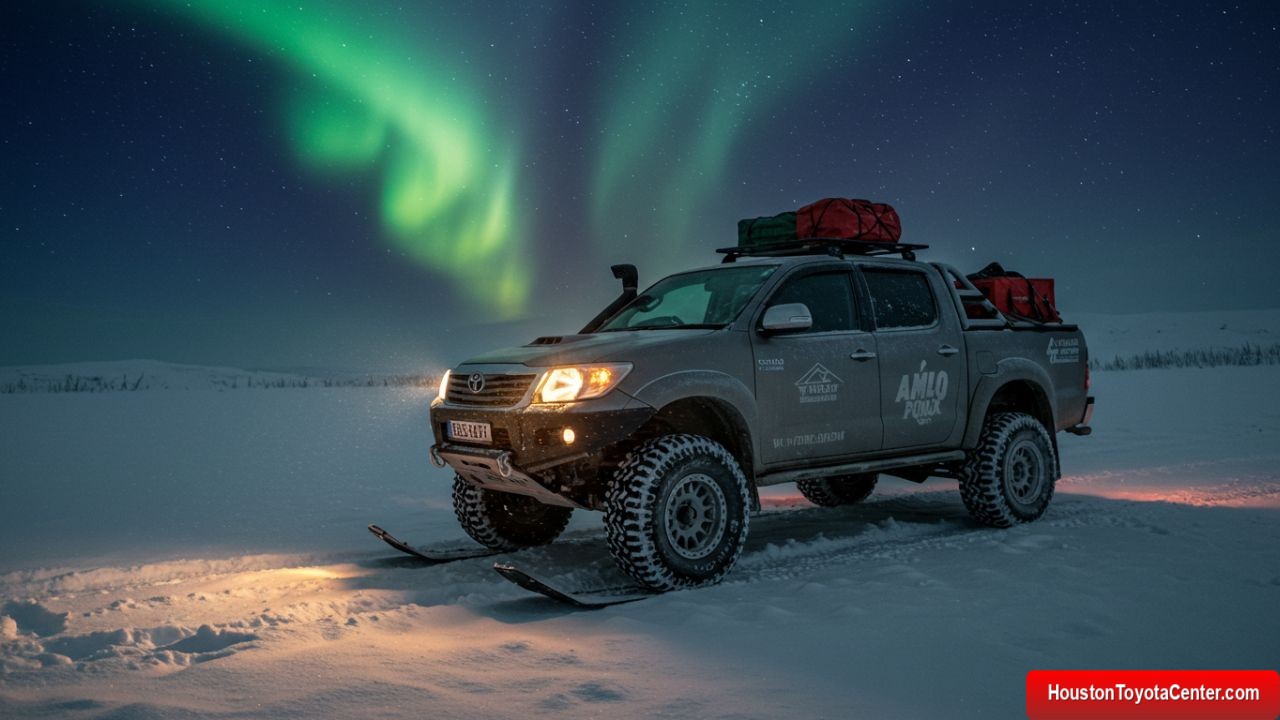When most trucks shiver and stall in sub-zero temperatures, the Toyota Hilux keeps going. This rugged pickup is not just a workhorse in temperate climates — it has proven time and again that it can survive, thrive, and dominate in Arctic conditions. From navigating snow-blanketed tundras to enduring ice storms and glacial terrain, the Hilux has become a symbol of resilience in the world’s coldest regions.
But what exactly makes the Toyota Hilux such a formidable machine in extreme cold? In this comprehensive look, we’ll explore its Arctic adventures, performance engineering, survival technologies, historical feats (including a trip to the North Pole), and why it continues to be the go-to vehicle for polar expeditions, research teams, and thrill-seekers alike.
Hilux in the Arctic: A Legendary Reputation
In 2007, the Toyota Hilux cemented its Arctic legacy when it was featured in BBC’s Top Gear North Pole Special. The goal? Drive to the Magnetic North Pole — a feat never before attempted by a passenger vehicle. Against impossible odds, including floating sea ice, blizzards, and minus-40°C temperatures, the Hilux prevailed.
Since then, the Hilux has become a standard vehicle for scientific expeditions in Greenland, Iceland, Alaska, and Canada. From glacier crossings to frozen rivers, its ability to handle permafrost and unpredictable Arctic weather is unmatched.
FREE: Quickly identify and understand problems with your vehicle 🚘
CLICK HEREWhat Makes the Hilux Arctic-Ready?
1. Engine Reliability in Sub-Zero Temperatures
The Hilux’s diesel engine is modified for Arctic use, with features such as:
- Heavy-duty block heaters
- High-capacity batteries with cold-start assist
- Synthetic cold-grade oils
- Fuel line insulation
When temperatures plunge to -50°C, standard vehicles suffer from frozen fluids, battery death, and engine seizure. The Hilux’s setup prevents these failures, offering reliable ignition and operation even in long Arctic nights.
2. Specialized Arctic Tires and Tracks
No ordinary tires can survive in Arctic terrain. Hilux Arctic conversions include:
- Extra-wide, studded snow tires
- Optional triangular track systems for snow traversal
- Tire pressure monitoring systems to adjust inflation based on terrain and temperature
These upgrades improve traction on black ice, deep snow, and compacted powder, making the Hilux almost unstoppable.
3. Reinforced Suspension and Frame
To survive in glacial terrain with sharp ice ridges and jagged rocks, the Hilux receives:
- Upgraded heavy-duty suspension
- Reinforced underbody skid plates
- Lifted chassis for improved ground clearance
These adaptations allow it to climb icy inclines, cross frozen rivers, and haul heavy gear without frame damage.
4. Cabin Comfort and Heat Efficiency
Even in a land of perpetual frost, the Hilux keeps its passengers comfortable:
- Advanced insulation to retain cabin heat
- High-efficiency Arctic heaters
- Seat warmers and dual-zone climate control
- Double-glazed windows for frost prevention
These comforts are essential when temperatures outside reach deadly lows and the vehicle becomes a survival capsule.
5. Fuel Efficiency and Storage
Carrying extra fuel is critical in remote Arctic zones where gas stations don’t exist. The Hilux is often equipped with:
- Auxiliary fuel tanks
- Jerry can storage
- High-mileage diesel efficiency
Many Hilux Arctic builds can run over 800 km (500 miles) without refueling — a lifesaver in vast frozen wildernesses.
Real-World Arctic Deployments of the Hilux
Let’s look at some notable Arctic missions where the Hilux played a starring role:
| Year | Location | Mission | Temperature Range | Outcome |
|---|---|---|---|---|
| 2007 | Magnetic North Pole | Top Gear Expedition | -35°C to -40°C | Successful – first car to reach the North Pole |
| 2010 | Greenland Ice Sheet | Arctic Trucks Scientific Support | -20°C to -50°C | Provided logistics support for climate researchers |
| 2015 | Icelandic Volcanoes | Emergency monitoring during eruptions | -15°C to -30°C | Delivered equipment across snow-covered lava |
| 2021 | Northern Canada Wilderness | Polar bear habitat mapping | -45°C | Carried drones and sensors deep into tundra |
Engineering Partnerships: Toyota & Arctic Trucks
Much of the Hilux’s Arctic performance stems from Toyota’s collaboration with Arctic Trucks, an Iceland-based company that specializes in modifying vehicles for polar survival.
These customizations include:
- Chassis lifts of up to 12 inches
- Custom fuel systems
- Lightweight body panels to reduce snow drag
- Cargo management for ice-core samples, survival kits, and scientific gear
This partnership allows Toyota to test extreme engineering that influences global vehicle design — what survives the Arctic tends to excel everywhere else.
Survival Mode: Using the Hilux as a Mobile Arctic Shelter
In many expeditions, the Hilux becomes the only safe refuge. Here’s how it functions as a survival station:
- Thermal insulation keeps interior above freezing even without idling
- Radio and GPS beacon connectivity for emergency location
- Snow chains and recovery winches in case of entrapment
- Modular sleeping platforms and tent attachments
Researchers have lived inside their Hilux for weeks at a time, braving storms, avalanches, and whiteouts. It’s not just a truck — it’s a mobile arctic base.
Hilux vs. the Cold: How It Compares to Other Trucks
Here’s a comparison of the Hilux to other well-known pickups under Arctic conditions:
| Feature | Toyota Hilux (Arctic Spec) | Ford Ranger | Chevy Colorado | Nissan Frontier |
|---|---|---|---|---|
| Engine Start at -40°C | ✅ Reliable | ⚠️ Intermittent | ⚠️ Requires prep | ⚠️ Requires prep |
| Stock Suspension Survival | ✅ Arctic Upgraded | ❌ Often fails | ⚠️ Limited | ⚠️ Limited |
| Snow Traction Capability | ✅ High (Custom Tracks) | ⚠️ Moderate | ⚠️ Moderate | ⚠️ Moderate |
| Cabin Heating Efficiency | ✅ Advanced Arctic Heating | ⚠️ Standard | ⚠️ Standard | ⚠️ Basic |
| Arctic Expeditions Usage Rate | ✅ Very High | ❌ Rare | ❌ Rare | ❌ Rare |
The Psychological Comfort of the Hilux
In Arctic conditions, it’s not just physical — it’s psychological. Knowing your vehicle will not fail builds confidence. Researchers often credit the Hilux with:
- Reducing stress during long missions
- Providing a constant, familiar routine
- Being a symbol of dependability in chaos
Even seasoned Arctic veterans say, “If I had to choose between a satellite phone or a Hilux, I’d take the Hilux. It won’t lose signal.”
Climate Testing: Toyota’s Arctic Labs
Before any Hilux reaches the market, it’s subjected to extreme climate simulation in Toyota’s Arctic test facilities. These include:
- Cold chambers set to -60°C
- Wind tunnels mimicking blizzard conditions
- Icy incline tracks
- Freeze-thaw endurance tests
The goal: ensure that every component, from electronics to exhaust pipes, can survive years of polar abuse.
Can You Buy an Arctic-Ready Hilux?
While the Arctic-modified Hilux isn’t sold directly from Toyota showrooms, Arctic Trucks offers conversion packages. Based on your needs, they can outfit your Hilux with:
- Arctic T3 and T6 packages
- Snow tracks
- Auxiliary heaters
- Reinforced axles and winches
- Custom arctic livery
It’s not cheap — full conversions can cost upward of $50,000 on top of the vehicle price — but for Arctic explorers, it’s worth every penny.
Conclusion: More Than a Truck, It’s a Lifeline
In the Arctic, the difference between survival and disaster can hinge on one thing: trust in your machine. The Toyota Hilux has earned that trust — not just through advertising, but through real-world, deadly serious performance in the harshest places on Earth.
Whether it’s crossing glacial rivers, driving over sea ice, or sitting still through a polar storm, the Hilux remains unshaken, unstoppable, and unchallenged.
When the world freezes, the Hilux moves.


Leave a Reply